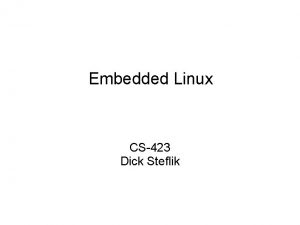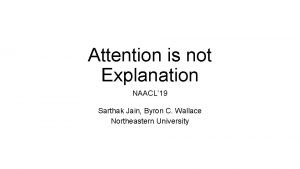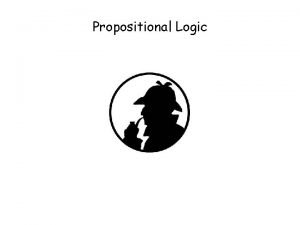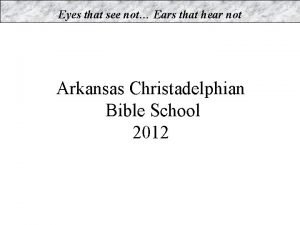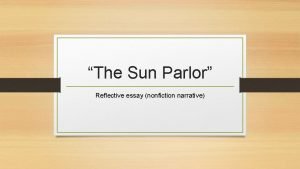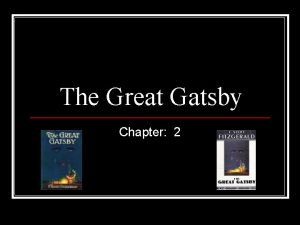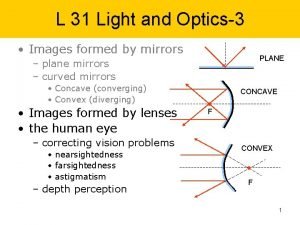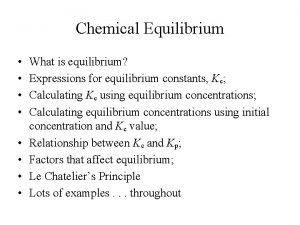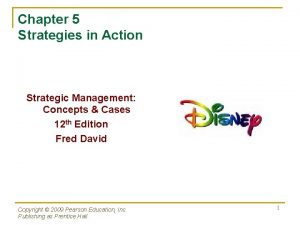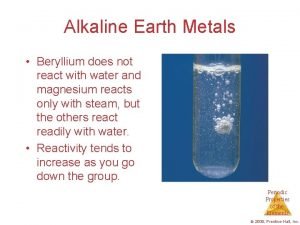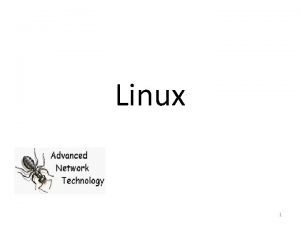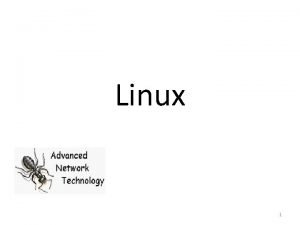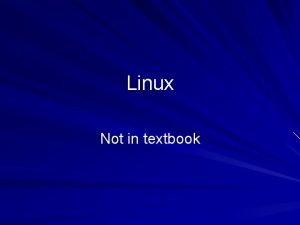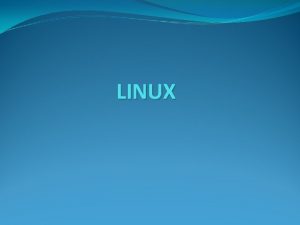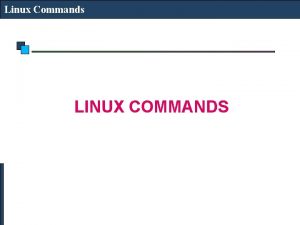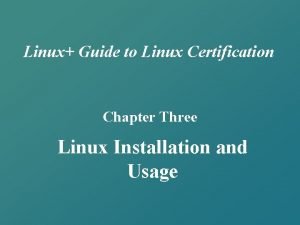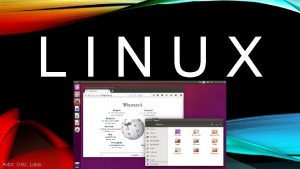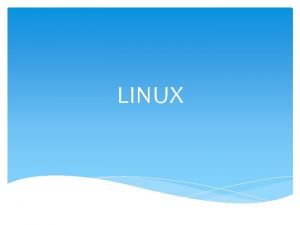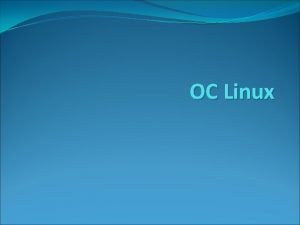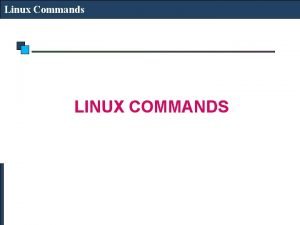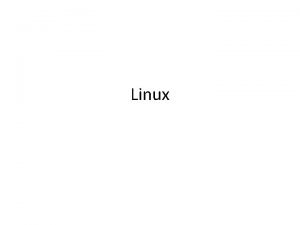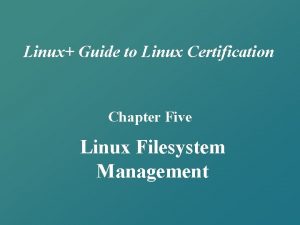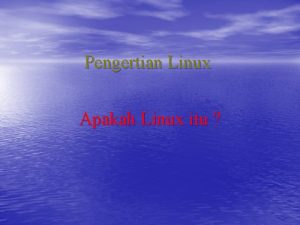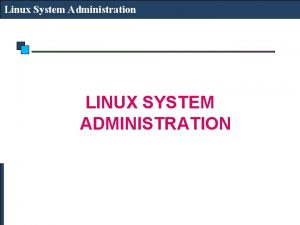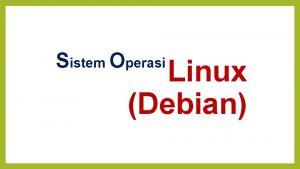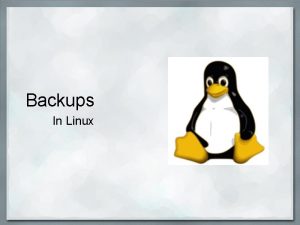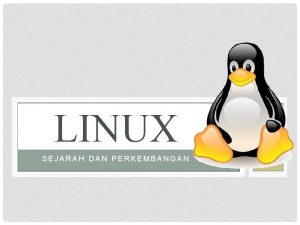Introduction to Linux What is Linux Why Not
![Introduction to Linux • • What is Linux? Why [Not] Linux? Linux Distributions Shells Introduction to Linux • • What is Linux? Why [Not] Linux? Linux Distributions Shells](https://slidetodoc.com/presentation_image_h2/5edd9a83d4033603286291bb70edc3b1/image-1.jpg)




























- Slides: 29
![Introduction to Linux What is Linux Why Not Linux Linux Distributions Shells Introduction to Linux • • What is Linux? Why [Not] Linux? Linux Distributions Shells](https://slidetodoc.com/presentation_image_h2/5edd9a83d4033603286291bb70edc3b1/image-1.jpg)
Introduction to Linux • • What is Linux? Why [Not] Linux? Linux Distributions Shells Editors Commands Creating a makefile Supplementary Slides 2 1

What is Linux? • Unix-like operating system • Primarily a command-line OS requiring user to enter commands on the keyboard – Has a GUI called X Windows that operates similarly to MS Windows • Traditionally designed for more technical, hands-on computer users – High performance and system flexibility are major concerns – Rapidly joining the group of OS for the general consumer • More often used as a filer server, Web server, or email server than as a desktop OS. Supplementary Slides 2 2

Origins of Unix/Linux • 1969: Initial version of Unix written in assembly language – By Ken Thompson and D. Ritchie at AT&T Bell Labs • Later rewritten in C for easier modification – Also to increase the number of mainframe and minicomputers on which Unix can run • 1974: Unix licensed to interested universities as a development tool • Students at licensed universities began developing and sharing utility programs to perform small but important tasks – some of these programs still part of the Unix kernel • Kernel: part of the OS code closest to the machine and activates h/w components directly or through another s/w layer Supplementary Slides 2 3

Origins of Unix/Linux (cont’d) • Many universities began to use Unix to share research data with other universities and industry over telephone lines – marked the beginning of the Internet and Internet Protocols (IP) • Unix "clones" developed over the years – typically modified Unix to make it accessible to the desktop user • One such successful clones resulted in the Linux OS – Initiated by Linus Torvalds, then a student at the Univ. of Helsinki Supplementary Slides 2 4

Linux Strengths • Stability – Linux rarely crashes – Written by programmers writing for other programmers (no deadlines, show one’s ingenuity etc) – Designed to be upgraded and modified "on the fly" • Security – Interested developers help identify & fix security problems – Developers said to create software updates to fix problems within 24 hours! • Resource-use economy – Designed to use limited hardware resources efficiently – Makes better use of hardware than almost any other OS – Translates into speed when more extensive resources available • A Mutitasking, Multiuser, Multiprocessing System – Can run many programs at the same time through preemptive multitasking – Many users can log in to the same system over a network and run programs – Supports multiple CPUs on the same computer using symmetric multiprocessing Supplementary Slides 2 5

Linux Strengths (cont’d) • Flexibility, extensibility – Source code available to users – Allows technically able folks to modify and extend the system the way they want • Open source – Faster and better software testing and refinement process - large number of software authors and beta testers • Linux is “free” – Acquired with little amount money • Generally handles network connections better than Windows – Developed by a team of programmers over the Internet; networking features given high priority – Supports most of the major protocols, and quite a few of the minor ones Supplementary Slides 2 6

Linux Weaknesses • Is Linux trustworthy? – How can something that is free also be reliable? • Installation & use – Can be difficult to install particularly for users who are not familiar with Unix commands – Can be difficult for casual users to operate – Documentation can be spotty • Inconsistent User Interface – Because of different design goals, no consistency enforced among the various programs and utilities included in a standard Linux distribution. • Replication of packages – For example, a distribution may contain Mail Transfer Agents: sendmail, smail, qmail, and exim • Lack of commercial applications – Not many applications are available for Linux on the desktop Supplementary Slides 2 7

Linux Distributions • The Linux kernel does not provide the full functionality of a commercial OS • A Linux distribution typically has the kernel as its core with many other tools like – – – Networking utilities System administration tools Installation and documentation packages Graphical user interfaces Etc • Most of the added system utilities are drawn from the GNU project of the FSF – Linux distributions often called GNU/Linux OS • There are many Linux distributions available Supplementary Slides 2 8

Popular Linux Distributions • Red Hat Linux - www. readhat. com – The most widely used distribution in the world – Main goal was to provide an easy-to-install, pre-configured system that comes complete with many applications • Open. Linux - www. calderasystems. com – The first to provide a fully graphical installation procedure – Aimed at Business users. Produced by Caldera Systems • Mandrake - www. linux-mandrake. com – Built on Red Hat Linux – Additions include installation procedure in many languages • Stampede - www. stampede. com – A distribution optimized for speed Supplementary Slides 2 9

Popular Linux Distributions • Debian - www. debian. org – Debian does not have company behind it: created and maintained by developers of free software – Primary goals are provision of an easy upgrade technique and high-secure components • Slackware - www. cdrom. com – One of the first Linux distributions; still maintained by its original creator, Patrick Volkerding – Probably the second-best known Linux distribution • Su. SE - www. Su. SE. com – The leading German distribution - with a huge collection of packages – Full installation requires > 4 GB Supplementary Slides 2 10

Which Distribution to Use? • All Linux distributions do more-or-less the same things • Choice is sometimes a matter of preference • Linux newbies – Best served by Xandros, Su. SE, Fedora, Mandrake, or possibly Red Hat • Experienced administrators – Able to cope with any of the Linux distributions. • Non-x 86 computers – For a non-Intel computer, you must select an appropriate distribution. – For Power. PC (Macintosh) systems, your main choices are Mandrake 9. 1, Su. SE 7. 3, Debian 3. 0 Supplementary Slides 2 11

The Shell • While the kernel interacts with the hardware and other software, the shell interacts with the user and the kernel • A shell is a program that provides the traditional, textonly user interface for Unix-like operating systems. • Primary function: read and execute commands – Makes it easy for users to launch programs and work with files • The shell derives its name from the fact that it is an outer layer of an operating system. • Every Unix-like operating system has at least one shell program, and most have several. Supplementary Slides 2 12

Common Shells • sh (the Bourne Shell) is the original Unix shell, and it is still in widespread use today. – Written by Stephen Bourne at Bell Labs in 1974 – Missing functions expected: file name completion, command editing, command history etc • csh or C shell: the syntax of this shell resembles that of the – Syntax similar to that of the C programming language. – Sometimes asked for by programmers. • tcsh or Turbo C shell: – A superset of the common C shell – Enhancing user-friendliness and speed • ksh or the Korn shell: sometimes appreciated by people with a UNIX background. – A superset of the Bourne shell – Proprietary, written by David Korn • bash (Bourne-again shell) - the default shell on Linux. – Has many more commands than sh, making it a powerful tool for advanced users. Supplementary Slides 2 13

Editors • Everyone needs a text editor – Pick one and learn how to use it well • People are fanatical about their editor – No single best editor? • Several choices available: – vi Standard UNIX editor – Emacs Extensible, Customizable Self. Documenting Display Editor – pico Simple display-oriented text editor – The XEDIT-like editor – Xedit X windows text editor – Nedit X windows Motif text editor Supplementary Slides 2 14

Commands • See P. Baumann slides Supplementary Slides 2 15

Introduction to Makefiles • Managing a project consisting of many source files can be tedious • For example, consider a project with tens of files – source files, header files and libraries all of which may change during development • How do we know which files to recompile or relink with when some files change? • Fortunately, Linux provides a tool, the make program, that greatly simplifies this • make keeps a record of dependencies between files – Recompiles/relink only those files that changed since the last update • Thus, instead of managing these tasks manually, make can be your automatic dependency manager – gives you more time to do other important things Supplementary Slides 2 16

Introduction to Makefiles (cont’d) • make is best suited for C programming – can be used with any programming language whose compiler can be run with a shell command • It has knowledge of how compilers work and can sometimes figure things out for itself (see later) • make generates commands using a description file known as a makefile. – These commands are then executed by the shell • make expects the file name to be Makefile or makefile • The makefile is basically a set of rules for make to follow to do its job • The major elements of a makefile are: – – – Dependency lines or rules Targets Dependents Macros (user-defined and internal) Comments Supplementary Slides 2 17

A Sample Makefile CC = mpicc FC = mpif 77 # SOURCE CODE SRC=inner. c OBJ=inner. o inner: $(OBJ) $(CC) -c $(SRC) $(CC) -o $@ $(OBJ) run: make inner mpirun -np 4 inner clean: rm -f *. o *% *~ a. out inner Supplementary Slides 2 18

Components of the Makefile • The first two and the last two of the following lines are macros: CC = mpicc FC = mpif 77 # SOURCE CODE SRC=inner. c OBJ=inner. o • The middle line above, starting with #, indicate make comments • Macro names are traditionally given in uppercase letters – The macro value (at the right of the equality) can be a file name, a directory, a program to execute or just about anything • Macros can have empty right-hand sides (assigned the null string) – make ignores undefined macros and those with null string values • Macros are referenced by prefixing them with dollar sign, as in $(SRC) • Macros can include other macros as in: LFLAGS = -L$(PVM_ROOT)/lib/$(PVM_ARCH) Supplementary Slides 2 19

Components of the Makefile (cont’d) • A makefile consists of entries like: inner: $(OBJ) $(CC) -c $(SRC) $(CC) -o $@ $(OBJ) • The first line of an entry is the dependency line consisting of a target and dependents – The target is at the left of the colon (inner in this example) and the dependents to the right (inner. c in this example) • The second line is one or more command lines, which tell make what to do if a dependent is newer than the target • The syntax of a makefile requires that each command line must be indented using a tab. • A dependency line can have a series of commands associated with it, like: run: make inner mpirun -np 4 inner Supplementary Slides 2 20

Using the Makefile • Given the above makefile and assuming you are in the directory where it was saved (as Makefile or makefile): sahalu@linux>make inner mpicc -c inner. c -o inner. o • The above command tells Linux that you want to create a new version of the executable program inner – Notice how the macros are expanded and the commands issued to the shell for execution • inner is referred to as the target of this make operation • The object file(s) that are linked together to create the executable are known as the dependents – The only object here is inner. o referenced as $(OBJ) • The source code files that are compiled to create an object files are also its indirect dependents – The only source file here is inner. c Supplementary Slides 2 21

Using the Makefile (cont’d) • Observe the targets run and clean carefully in our example makefile – They both have no dependents – run is used to call make and to initiate mpirun • When a target has no dependents, make executes the supplied commands – provided there is no file with the same name as the target in the current directory • If all the dependencies of a target, are up to date, make does nothing except inform you of the following: sahalu@linux>make target ‘target' is up to date • You can supply more than one target to make at the same time: sahalu@linux>make run clean • If you supply a target that does not exist, you get: sahalu@linux>make ics make: *** No rule to make target `ics'. Supplementary Slides 2 Stop. 22

Using Makefiles • Note that make executes each command line associated with a rule as if the command had its own shell. • Thus, the command cd somewhere mv *. c anotherwhere may not behave the way you may have intended. • Use the following syntax to remedy such situations: dependency line command 1; command 2; command 3; . . . • or dependency line command 1; command 2; command 3; • Note that if you use a backslash to continue a line, as above, the backslash must be the last character before the end-of-line character. Supplementary Slides 2 23

Internal Macros • make has internal macros that it recognizes for commonly used commands. – The C compiler is defined by the CC macro, and – The flags that the C compiler uses are stored in the CFLAGS macro. • Two other internal macros are $@ and $? – The $@ macro always denotes the current target; – The $? macro refers to all the dependents that are newer than the current target. – Both of these macros can only be used within command lines. • make knows that C compilers compile files with. c suffixes, and generate files with. o suffixes. • This knowledge is encapsulated in a suffix rule: – make examines the suffix of a target or dependent to determine what it should do next. Supplementary Slides 2 24

Suffix Rules • The default suffix rules are as follows: . SUFFIXES: . o. c. s. c. o: ${CC} ${CFLAGS} -c $<. s. o: ${AS} ${ASFLAGS} -o $@ $< • First line: a dependency line stating the suffixes that make should try to find rules for if none are explicitly written in the makefile. • Second line: compile each. c file whose corresponding object file (. o) is out of date. • Third rule is a similar directive to rule 2 but for assembler files. • The new macro $< has a similar role to that of the $? directive, but can only be used in a suffix rule. – It represents the dependency that the rule is currently being applied to. Supplementary Slides 2 25

Makefile 2 someonehappy: main. o dothis. o itquick. o /usr/happy/lib/likeatree. a cc -o someonehappy main. o dothis. o itquick. o /usr/happy/lib/likeatree. a main. o: main. c cc -c main. c dothis. o: dothis. c cc -c dothis. c itquick. o: itquick. s as -o itquick. s fresh: rm *. o maybe. h: yes. h no. h cp yes. h no. h /users/sue/ Supplementary Slides 2 26

Makefile 2 with Macros CC = /usr/bin/cc AS = /usr/bin/as OBJS = main. o dothis. o itquick. o YN = yes. h no. h LIB_FILES = /usr/happy/lib/likeatree. a someonehappy: ${OBJS} ${LIB_FILES} ${CC} -o someonehappy ${OBJS} ${LIB_FILES} main. o: main. c cc -c main. c dothis. o: dothis. c cc -c dothis. c itquick. o: itquick. s ${AS} -o itquick. s fresh: rm *. o maybe. h: ${YN} cp yes. h no. h /users/sue/ Supplementary Slides 2 27

Makefile 2 with Internal Macros OBJS = main. o dothis. o itquick. o YN = yes. h no. h LIB_FILES = /usr/happy/lib/likeatree. a someonehappy: ${OBJS} ${LIB_FILES} ${CC} -o $@ ${OBJS} ${LIB_FILES} main. o: main. c cc -c $? dothis. o: dothis. c cc -c $? itquick. o: itquick. s ${AS} -o $@ $? fresh: rm *. o maybe. h: ${YN} cp $? /users/sue/ Supplementary Slides 2 28

Makefile 2 with Suffix Rules OBJS = main. o dothis. o itquick. o YN = yes. h no. h LIB_FILES = /usr/happy/lib/likeatree. a someonehappy: ${OBJS} ${LIB_FILES} ${CC} -o $@ ${OBJS} ${LIB_FILES} fresh: rm *. o maybe. h: ${YN} cp $? /users/sue/ Supplementary Slides 2 29
 Andreas carlsson bye bye bye
Andreas carlsson bye bye bye English 9 vocabulary unit 1
English 9 vocabulary unit 1 Does this table represent a function why or why not
Does this table represent a function why or why not Does the table represent a function why or why not
Does the table represent a function why or why not Why or why not
Why or why not Don't ask why why why
Don't ask why why why Kernel linux security module m1 support
Kernel linux security module m1 support Guilots
Guilots If you are not confused you're not paying attention
If you are not confused you're not paying attention Informal-casual
Informal-casual Attention is not explanation
Attention is not explanation Not too broad and not too narrow
Not too broad and not too narrow Q then p
Q then p Small just
Small just Love is not all analysis
Love is not all analysis Ears that hear and eyes that see
Ears that hear and eyes that see Pp ran
Pp ran We cannot manage what we cannot measure
We cannot manage what we cannot measure We will not be moved you're standing with us
We will not be moved you're standing with us Not a rustling leaf, not a bird in flight
Not a rustling leaf, not a bird in flight You cannot not communicate
You cannot not communicate What is the topic of the essay the sun parlor
What is the topic of the essay the sun parlor How does myrtle react to tom’s arrival
How does myrtle react to tom’s arrival In sooth i know not why i am sad
In sooth i know not why i am sad Fructose is non reducing sugar
Fructose is non reducing sugar Refraction at spherical surface
Refraction at spherical surface How to read pipe blueprints
How to read pipe blueprints K equilibrium formula
K equilibrium formula Strategic management concepts
Strategic management concepts Alkaline earth metals react with water
Alkaline earth metals react with water







